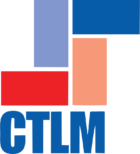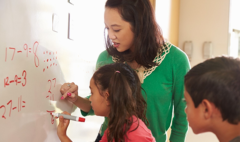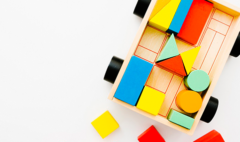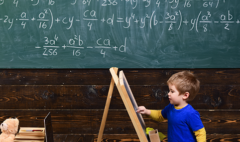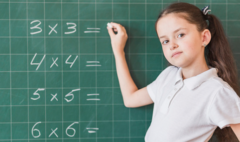CCSS-M: Non-negotiable Skills at the Middle School: Grades Seven and Eight
March 31, 2021 2021-04-01 10:59CCSS-M: Non-negotiable Skills at the Middle School: Grades Seven and Eight
CCSS-M: Non-negotiable Skills at the Middle School: Grades Seven and Eight
The goal of elementary school (K through 6) arithmetic is for students to master additive reasoning—the inverse relationship of addition and subtraction (achieved K through 2), multiplicative reasoning—the inverse relationship of multiplication and division (achieved 3 through 4), and proportional reasoning—a relationship between two quantities (achieved 5 through 6).
With additive reasoning we can compare only two quantities by their sizes (smaller than or greater than, or how much smaller or greater) whereas multiplicative reasoning helps students to compare (beyond relative sizes) two quantities in terms of each other, e.g., one quantity can be expressed in terms of the other, such as it is twice as much or is going to be three times larger than now. The transition from additive reasoning (a one dimensional linear concept) to multiplicative reasoning (a two-dimensional concept—represented by an array or the area of a rectangle) is cognitively an important milestone.
Multiplicative reasoning provides the ability to understand and apply proportional reasoning—ability to make comparisons and define relationships between objects and quantities in multiplicative form rather than additive form (5 through 6). It provides the ability to predict the state of the two quantities in a future state, if the relationship persists. Having multiplicative reasoning and extending it to proportional reasoning is a great achievement on the part of children and is the beginning of algebraic thinking in the true sense. The understanding and competence in proportional reasoning facilitate students’ transition from arithmetic to algebra.
Many topics in upper elementary and middle school mathematics and science curricula require proportional reasoning, including problem solving with fractions, decimals, percentages, scale, transformations of objects/shapes, probability, trigonometry, conversions of measurements, geometry of shapes, density, molarity, speed, acceleration, force, mapping, scale drawing, etc.
At the end of elementary school, children should have strong numeracy skills (number concept, numbersense, and the four operations of addition, subtraction, multiplication, and division on whole numbers), on one hand, and proportional reasoning, on the other.
The success in the concepts to be learnt during the upper elementary and middle school mathematics is dependent on a few important concepts: mastery of ten counting numbers (particularly decomposition/composition and sight facts); numbersense (arithmetic facts, particularly multiplication facts and place value); numeracy; divisibility rules; prime factorization; short-division; and concept and operations on fractions.
Middle School Years
The core of elementary and middle school mathematics features understanding of and operations of addition, subtraction, multiplication, and division on whole numbers, fractions, integers, rational numbers, and real numbers. With this understanding and competence, children can understand and master other related content easily and effectively.
The goal of mathematics education during the middle school years is to arrive at generalizations, extrapolations, and abstractions from arithmetic problems and express them through algebraic symbolism and then manipulate these abstractions/symbols. At the elementary school level, the focus and competence are on solving problems arising from specific contexts whereas, in algebra, the algebraic models are applied to solving classes and systems of problems rather than specific problems in particular contexts.
This generalization process begins with students realizing that algebra, initially, is generalized arithmetic and then extends to arithmetic of algebraic expressions, relations and functions.
In the middle school years, the objective is for students to make the transition from arithmetic to algebra. In other words, during the middle school years, the focus is on developing algebraic thinking and applying it. However, it should be remembered that algebra is not a collection of procedures or manipulation of symbols; it is making connections.
School mathematics and algebra have always had the goal of training students to manipulate numerical and algebraic symbols. The purpose of this manipulation is to solve problems not only by arithmetical models but also through algebraic models and systems of equations, inequalities, and representations—both algebraical and geometrical.
In CCSS-M, the framers insist that algebra is not to be introduced just as a collection of isolated procedures, and they assume that students have a reasonably well developed understanding of arithmetic principles and procedures (especially fluency in the execution of the four operations on whole numbers and integers, and the understanding that every arithmetic operation has its inverse operation, etc.).
The framers of CCSS-M advocate that algebraic concepts and operations should be introduced by developing arithmetic patterns and then converting them to the algebraic generalizations to ensure that students recognize why algebra is an important area of mathematics to learn. If the students do not see this early on, it is much harder to get them interested later. It means students clearly understand the concept of rational numbers and, in the seventh grade, extend the arithmetic operations on integers and fractions to operations on the rational number system.
In eighth grade, students should extend their understanding of the rational number system to the real number system and understand and master the arithmetic operations on the real number system. They should understand the nature of the “real number” line. They should see the applications of algebraic models in a variety of quantitative and spatial situations using real numbers.
They should generalize quantitative reasoning to algebraic reasoning—understand how to operate on algebraic expressions, equations, and inequalities; express relationships through functions, which provides the ability and tools to understand relationships between systems; know operations on functions; expand the intuitive and concrete spatial relationships (such as transformations) to formal geometrical truths and relationships; integrate quantitative and spatial reasoning and relationships in problem situations; and solve problems through arithmetic, algebraic, geometrical, statistical, and probabilistic models. More specifically, the content in these grades are:
Seventh Grade
The focus of seventh grade is to extend the number system to include rational numbers. Students should understand and master the concepts of integers and rational numbers, their relationship with other numbers and mastery of operations on them. It means:
(a) understanding the difference between numeral (representation of quantity, e.g., I took three steps is represented as the numeral 3) and number (a directed numeral, e.g., I took three steps forward is represented as +3 and I took three steps backward is represented by –3) and operations on them;
(b) understanding the definition—a number that can be written as the ratio , where a and b are integers, b ≠ 0, and a and b are relatively prime—with 1 as the greatest common factor; representing them as decimals—a rational number can be represented by (i) terminating decimal (.459), or (ii) repeating, non-terminating decimal ; and using rational numbers in multiple contexts—quantitative and spatial reasoning;
(c) understanding and mastery of operations on rational numbers, for example, it means that: operations (such as multiplication) are extended from fractions to rational numbers by requiring that they continue to satisfy their properties, particularly the distributive property, leading to products such as (−1)(−1) = +1;
(d) understanding that the rules for operations on signed numbers are well-founded; for example, by emphasizing the properties of operations, students are able to extend the situations such as: (−m)(−n) = mn for any integer m and n to the product of rational numbers. They see them as a general case rather than a special one—indicating entry into algebraic thinking in the formal sense;
(e) interpreting the operations (e.g., products of) of rational numbers by describing real world contexts.
The second focus of seventh grade mathematics is acquiring facility in working with and applying rational numbers in multiple contexts such as extending the concept of proportional reasoning and mastering it. It should include concepts such as: proportion, unit price, scale factor (stretching and shrinking), slope, conversions, etc.
(a) from extending the understanding of and applying proportional reasoning and relationships to learning new mathematical concepts and solving real world problems
(b) deeper understanding of and operations on rational numbers involving expressions, linear equations and inequalities;
(c) solving problems involving similarity, scale drawings, rate of change, slope, and informal geometric constructions;
(d) working with two- and three-dimensional shapes to solve problems involving area, surface area, and volume, first treating them intuitively and concretely—conducting experiments such as three cones with the same base and height can fill the cylinder with the same height and base, showing that the volume of the cone is one-third the volume of the cylinder—and similarly considering generalized situations of particular situations (e.g., the surface area of a prism is equal to the product of the perimeter of the base and height plus the sum of the area of the two bases; the volume of the prism is equal to the product of the area of the base and the height) of simple and compound shapes, figures, and diagrams; and
(e) drawing inferences about populations based on samples.
Eighth Grade
In eighth grade, the focus is on understanding and operating on real numbers—each real number has a unique place on the real number line (e.g., a real number can be located on the number line, and each point on the number line represents a real number). The set of real numbers is the union of the sets of rational and irrational numbers and a real number can be represented as (a) a terminating decimal, (b) repeated non-terminating decimal, or, (c) non-repeating, non terminating decimal (e.g., .o1oo1oo1ooo1oooo1….; or .12123123412345123456…, etc.). The mastery of numeracy skills and operations on integers and rational numbers is good preparation for understanding and operating on real numbers.
Students should be fluent in using symbols so as to generalize arithmetical procedures to algebraic operations, abstracting from quantitative and spatial situations, and developing algebraical and geometrical reasoning to understand the algebra of functions, linear equations and inequalities. In particular:
(a) Formulating, reasoning, and performing operations on algebraic expressions and equations, including modeling an association in bivariate data with a linear equation, and solving linear equations and systems of linear equations and inequalities using multiple methods and knowing the appropriateness, efficiency, and limitations of a particular method;
(b) Grasping the concept of a function and using functions to describe quantitative, spatial (geometric), and probabilistic relationships;
(c) Analyzing two- and three-dimensional space, shapes, figures, and diagrams using distance, angle, similarity, and congruence; relating 2- and 3-dimensional shapes; understanding and applying quantitative and spatial relationships and results such as the Pythagorean theorem; the trigonometric ratios in a right triangle; making conjectures based on observed patterns in quantitative and spatial relationships and then supplying reasons to prove or disprove those conjectures.
In eighth grade, students should use their understanding and mastery of operations on the real numbers to solve arithmetic, algebraic, geometric, and probabilistic problems.
They should understand patterns in quantities and graphs relating two variables. The conceptual heart of the matter is understanding relations among several quantities whose values change. Eighth grade mathematics must also include
- thinking about variables as measurable quantities that change as the situations in which they occur change;
- understanding that variables are not usually significant by themselves but only in relation to other variables and context.
- As time passes, the depth of water in a tidal pool increases and decreases in a periodic pattern.
- As bank savings rates increase, the interest earned on a fixed monthly deposit also increases, but when the interest earned is compounded, the new amount increases exponentially.
- In a sequence of squares having sides 1, 2, 3, 4, 5, …,n, …, the areas of those squares are 1, 4, 9, 16, 25, …,n2, …and the perimeters are 4, 8, 12, 16, 20, …., 4n,….
- For any rectangle of base b and height h, the perimeter p is 2b + 2h.
Related Posts
Effective teaching of mathematics
April 9, 2021
2,962 views
Enriching mathematics experiences for kindergarten through second grade students
April 9, 2021
2,189 views
Number war games for teaching and reinforcing number concept
April 9, 2021
2,229 views
Processing speed and working memory
April 9, 2021
3,338 views
Dyscalculia and other learning problems in mathematics
April 9, 2021
1,602 views
Recent Posts
Recent Comments
Archives
Categories
